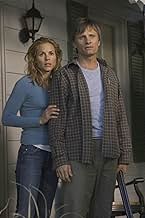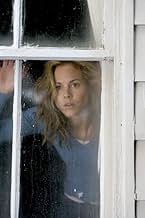Un uomo mite diventa un eroe locale grazie a un episodio di violenza, che scatena ripercussioni che sconvolgeranno la sua famiglia.Un uomo mite diventa un eroe locale grazie a un episodio di violenza, che scatena ripercussioni che sconvolgeranno la sua famiglia.Un uomo mite diventa un eroe locale grazie a un episodio di violenza, che scatena ripercussioni che sconvolgeranno la sua famiglia.
- Candidato a 2 Oscar
- 37 vittorie e 84 candidature totali
Trama
Lo sapevi?
- QuizFor the sex scene on the stairs, David Cronenberg was concerned about the two actors getting hurt on the hard wooden steps. He asked his stunt man whether or not he had any stunt pads to soften up the stairs. The stunt man laughed, saying that in the twenty years he had been working as a stunt man, no director had ever asked him for stunt pads for a sex scene. Pads were not used for most of the scene however, and in the shot when Edie is naked on the bed with bruises visible on her back, make-up was used to hide the amount of bruises that Maria Bello received from the scene.
- BlooperIn the high school softball game, the bully comes up to the plate carrying a wooden bat, but the sound heard when he hits the ball is the sound of an aluminum bat.
- Citazioni
[last lines]
Richie Cusack: [Joey holds a gun to Richie's head] Jesus, Joey.
Tom Stall: [as Joey shoots Richie in the head, then stands over his dead body] Jesus, Richie.
- Versioni alternativeThere are some minute differences between the US and the International version when it comes to some of the violent scenes:
- Fogarty's thug, who gets his nose smashed into his skull has more blood spurt out in the International version in the shot where he is dying on the ground.
- When Joey stomps on Richie's thug's throat, he spits blood (instead of it 'welling up') and the sound effect of the neck breaking is louder. Both shots last the same length of time and use the same take, the amount of blood was simply toned down digitally for the MPAA. Most video versions outside the U.S. use the 'international version' but the shots appear in the supplements on the U.S. DVD (In the featurette titled 'Violence's History', Cronenberg shows the U.S. and international cut scenes side by side and explains the reason why there wasn't a standard 'unrated' version in the U.S. was because the changes were so small).
- ConnessioniEdited into A History of Violence: Deleted Scene - Scene 44 (2006)
Recensione in evidenza
We are in a a small community driven town, restaurant owner Tom Stall becomes the hero of the town when he shoots and kills two murdering robbers at the restaurant. Not long after, facially scarred Carl Fogarty arrives in town proclaiming that Tom is actually a former gangster from Philadelphia who needs to go back to pay his dues. As Fogarty and his Hench Men put the pressure on, Stall and his family are in danger of being overwhelmed with violence and mistrust.
One thing that can never be said about David Cronenberg is that he is a very predictable director, his output of course, if we are all honest, is very up and down, bewildering critics and fans in equal measure. Thankfully A History Of Violence finds Cronenberg on particularly devilish form, taking the graphic novel origins of the piece, written by John Wagner & Vince Locke, and crafting a modern day Western that is using violence as some sort of escalating disease. This is the point surely? The graphic violence (handled with morose tension by Cronenberg) is the main character in the film, regardless of any past history that Stall may have had, the violence arrives into this family, totally unwanted and unexpected, and then latches on to them to maybe destroy them?
With that point of interest to note, A History Of Violence can be seen as a blood brother to Cronenberg's wonderful remake of The Fly, the unwanted entering the fray and spreading its disease to the point of no return. There is the use of the husband and wife's ongoing sex life as a seriously smart strand in the escalating story, where once at the beginning there is fluffy erotic intercourse, then the on going danger in their lives brings darkness and borderline sadism, it's very relevant, as is the son axis as he goes through a dramatic change when the violence and threats engulf the family. Cronenberg gleefully ties all the murky threads together to ask us for a reaction to the violence up there on the screen.
The cast, with the exception of a fish out of water performance from Ashton Holmes as the son, Jack, is fine. Viggo Motensen plays the duality of the role as Tom Stall with much verve, while Maria Bello shows exactly why she shouldn't be working for food in hopeless miscast assignments like The Mummy 3. Ed Harris gives us a nice line in villain duties, and William Hurt crops up late in the piece to almost steal the film with his darkly disturbing menacing point of worth. Peter Suschitzky's photography enhances the primary colours for added impact when the mood swings down dark roads, and Howard Shore's musical score is constantly ominous, where he blends his own score for Silence of the Lambs with a sort of Berlioz like edginess.
All in all it's a very interesting and sneakily crafty picture that above all else shows that when on form, Cronenberg still has very much to offer modern age cinema. Now, about Straw Dogs? 8.5/10
One thing that can never be said about David Cronenberg is that he is a very predictable director, his output of course, if we are all honest, is very up and down, bewildering critics and fans in equal measure. Thankfully A History Of Violence finds Cronenberg on particularly devilish form, taking the graphic novel origins of the piece, written by John Wagner & Vince Locke, and crafting a modern day Western that is using violence as some sort of escalating disease. This is the point surely? The graphic violence (handled with morose tension by Cronenberg) is the main character in the film, regardless of any past history that Stall may have had, the violence arrives into this family, totally unwanted and unexpected, and then latches on to them to maybe destroy them?
With that point of interest to note, A History Of Violence can be seen as a blood brother to Cronenberg's wonderful remake of The Fly, the unwanted entering the fray and spreading its disease to the point of no return. There is the use of the husband and wife's ongoing sex life as a seriously smart strand in the escalating story, where once at the beginning there is fluffy erotic intercourse, then the on going danger in their lives brings darkness and borderline sadism, it's very relevant, as is the son axis as he goes through a dramatic change when the violence and threats engulf the family. Cronenberg gleefully ties all the murky threads together to ask us for a reaction to the violence up there on the screen.
The cast, with the exception of a fish out of water performance from Ashton Holmes as the son, Jack, is fine. Viggo Motensen plays the duality of the role as Tom Stall with much verve, while Maria Bello shows exactly why she shouldn't be working for food in hopeless miscast assignments like The Mummy 3. Ed Harris gives us a nice line in villain duties, and William Hurt crops up late in the piece to almost steal the film with his darkly disturbing menacing point of worth. Peter Suschitzky's photography enhances the primary colours for added impact when the mood swings down dark roads, and Howard Shore's musical score is constantly ominous, where he blends his own score for Silence of the Lambs with a sort of Berlioz like edginess.
All in all it's a very interesting and sneakily crafty picture that above all else shows that when on form, Cronenberg still has very much to offer modern age cinema. Now, about Straw Dogs? 8.5/10
- hitchcockthelegend
- 16 nov 2008
- Permalink
I più visti
Accedi per valutare e creare un elenco di titoli salvati per ottenere consigli personalizzati
Dettagli
- Data di uscita
- Paesi di origine
- Sito ufficiale
- Lingua
- Celebre anche come
- Una historia violenta
- Luoghi delle riprese
- Aziende produttrici
- Vedi altri crediti dell’azienda su IMDbPro
Botteghino
- Budget
- 32.000.000 USD (previsto)
- Lordo Stati Uniti e Canada
- 31.504.633 USD
- Fine settimana di apertura Stati Uniti e Canada
- 364.000 USD
- 25 set 2005
- Lordo in tutto il mondo
- 61.385.065 USD
- Tempo di esecuzione1 ora 36 minuti
- Colore
- Mix di suoni
- Proporzioni
- 1.85 : 1
Contribuisci a questa pagina
Suggerisci una modifica o aggiungi i contenuti mancanti








































